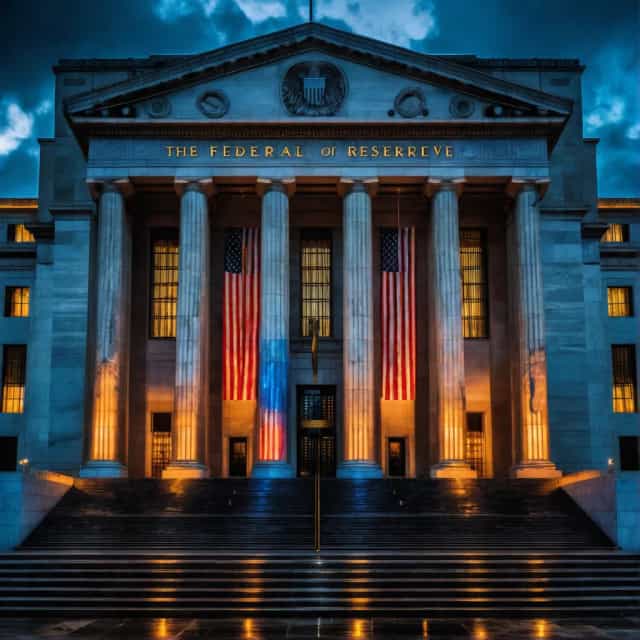
Image source: Block Media
Federal Reserve Reduces Rates by 0.25%, Paves Way for Three Cuts in 2023 Amid Economic Shifts
The Federal Reserve has initiated its first rate reduction of the year’s easing cycle, lowering the benchmark interest rate by 0.25 percentage points to a target range of 4.00% to 4.25%. This pivotal decision signals a broader shift in monetary policy, aiming to adapt to evolving economic conditions. Accompanying the rate cut, the Fed’s updated dot plot suggests the likelihood of three additional rate cuts this year—marking a more aggressive stance on easing than previously anticipated. The central bank has also adjusted its projections, revising its outlook for GDP growth upward.
The revised year-end target range for the federal funds rate now stands at 3.50% to 3.75%, down from June’s forecasted range of 3.75% to 4.00%. The median year-end rate forecast has been lowered to 3.6%, reflecting a 0.3 percentage point decrease compared to the 3.9% projection in June. These adjustments underscore the Fed’s shifting approach toward fostering economic resilience amid persistent inflationary and labor market challenges.
Fed Chair Powell Highlights Unique Economic Landscape
In a post-decision press conference, Federal Reserve Chair Jerome Powell stressed the extraordinary nature of the current economic environment. “Historically, weak labor markets tend to coincide with lower inflation, while strong labor markets raise inflation concerns," Powell stated. "However, we’re currently navigating a rare scenario where employment growth is decelerating alongside sustained inflationary pressures.” He further emphasized that "there is no risk-free path forward," reflecting the complexity of policymaking in this unprecedented macroeconomic situation.
Revised Economic Projections Signal Optimism in Growth
The Federal Reserve updated its economic projections, signaling moderate optimism regarding U.S. growth. The GDP growth forecast for 2023 was increased to 1.6%, up from 1.4% previously expected in June. Future outlooks for 2026 and 2027 were also adjusted upward to 1.8% and 1.9%, respectively. These revisions reflect the Fed’s confidence in sustained, albeit modest, economic expansion over the long term.
Core inflation for 2023 remains stable at 3.1%, with projections indicating a gradual decline over the next few years. Core inflation is expected to fall to 2.6% by 2026 and reach the Fed’s target of 2.1% by 2027. Labor market dynamics, however, suggest a slight cooling, with the unemployment rate forecast to rise from the current 4.3% to 4.5% by the end of the year before stabilizing at 4.3% by 2027. These projections highlight the balancing act the Federal Reserve faces between managing inflation and supporting broader economic stability.
Divergent Perspectives Among Fed Officials Reflect Uncertainty
The updated dot plot, a visual representation of rate forecasts from Federal Open Market Committee (FOMC) members, reveals significant division among policymakers. Eighteen officials foresee at least one more rate cut before the year-end, while one member projects as many as six additional cuts. Conversely, only one official advocated for maintaining the current rates, marking a sharp decline compared to the seven who held this position during June’s meeting. Addressing these variances, Powell remarked, “In an environment this extraordinary, it is natural for perspectives to vary broadly.” This divergence highlights the uncertainty underlying current policymaking as officials weigh competing signals from inflation data, employment trends, and global economic conditions.
Financial Markets React to Fed’s Dovish Stance Amid Stagflation Concerns
The markets reacted positively to the Fed’s actions, with prominent institutions such as Wells Fargo, Barclays, and Deutsche Bank raising their S&P 500 targets. Factors driving this optimism include sustained corporate earnings, AI-driven growth investments, and the Federal Reserve’s less hawkish stance on monetary policy. These indicators collectively point to potential upward momentum for equity markets.
However, not all analysts share the same confidence. Concerns over stagflation—a precarious economic condition characterized by slowed growth, entrenched inflation, and rising unemployment—remain at the forefront of discussion. Managing these risks will require careful navigation as the Federal Reserve works to keep inflation expectations in check while simultaneously leaving room for more rate reductions to mitigate labor market pressures.
Yahoo Finance highlighted the dual challenges facing policymakers: balancing inflation management with fostering economic flexibility amid signs of softening in the labor market. This delicate balancing act underscores the complexity of the Federal Reserve’s current strategy, as it seeks to harmonize its dual mandate of stable prices and maximum employment in a turbulent economic landscape.
Conclusion
The Federal Reserve’s decision to cut rates by 0.25% signals an inflection point in monetary policy, setting the stage for further easing measures throughout the year. With its upward growth revisions and long-term inflation projections, the Fed demonstrates cautious optimism in navigating a multifaceted economic environment marked by uncertainty. However, divergent perspectives among officials, along with lingering stagflation concerns, highlight the challenges inherent in shaping monetary policy amid unpredictable conditions. As markets continue to process the implications of the Fed’s dovish stance, the coming months will reveal whether these measures effectively balance the dual demands of economic growth and inflation control.










